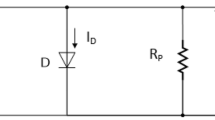Abstract
Photovoltaic cells efficiency can be effectively improved by maximum power point tracking (MPPT) technology. An improved MPPT control strategy is proposed to solve the current problems of poor convergence speed and accuracy of incremental conductance method. In this method, the P–U characteristic curve is divided into three sections: non-MPP sections, MPP-like section and MPP sections. In the non-MPP section, the constant voltage method is adopted to reduce the tracking time. In the MPP-like section, the incremental conductance method is adopted and its step size is improved, which effectively reduces the tracking time. In MPP section, particle swarm algorithm is adopted to improve tracking accuracy. Taking light intensity and temperature variation as examples, the proposed method and the traditional method are simulated respectively. Simulation results show that compared with the constant voltage method, the accuracy can be improved by more than 4% when the temperature or light intensity is changed, while maintaining the tracking speed. Compared with the traditional incremental conductivity method, the method can reduce the tracking time by 33% and improve the tracking accuracy by 1% when the light intensity or temperature changes.







Similar content being viewed by others
References
A machine learning based approach for phishing detection using hyperlinks information, AIHC, Springer, 2018
Abualigah LMQ, Hanandeh ES (2015) Applying genetic algorithms to information retrieval using vector space model. Int J Comput Sci Eng Appl 5(1):19
Abualigah LM, Khader AT (2017) Unsupervised text feature selection technique based on hybrid particle swarm optimization algorithm with genetic operators for the text clustering. J Supercomput 73(11):4773–4795
Abualigah LM, Khader AT, Hanandeh ES (2018) A combination of objective functions and hybrid Krill Herd algorithm for text document clustering analysis. Eng Appl Artif Intell 73:111–125
Dabra V, Paliwal KK, Sharma P et al (2017) Optimization of photovoltaic power system:a comparative study. Protect Control Modern Power Syst 2(2):29–39
Haifeng H, Wei Y, Wenyan Z (2014) Analysis and improvementof MPPT disturbance observer method for PV system. Power Syst Prot Control 42(9):110–114
Han P, Li Y, He X et al (2016) Improved pv multipeak power point tracking method combined with quantum particle swarm algorithm. Autom Electr Syst 40(23):101–108
Hu Y, Chen H, Xu R et al (2011) PV module characteristics effected by shadow problem. Trans China Electrotech Soc 26(1):123–128
Jian ZHU (2016) An improved pv cell maximum power point tracking method based on constant voltage method. Electron Technol Softw Eng 03:248–249
Liu M, Zang Y, FAN Y et al (2017) An adaptive MPPT control strategy based on variable step length incremental conductance method. Renew Energy 35(05):681–688
Mei Q, Shan M, Liu L et al (2011) A novel improved variable step-size incremental-resistance MPPT method for PV systems. IEEE Trans Ind Electron 58(6):2427–2434
Rong D, Liu F (2017) Research on improved disturbance observation method in pv MPPT. Proc CSU-EPSA 29(03):104–109
Rong Y, Chen L, Cui M et al (2014) A battery charging controlstrategy based on maximum power point tracking. PowerSyst Technol 38(2):347–351 (in Chinese)
Song GAO, Hao LUO, Ning HE et al (2015) Study of new variable step length incremental conductance method based on MPPT. Electr Drive 45(02):16–19
Sun H, Du H, Ji Y et al (2015) Mechanism analysis and simulation of photovoltaic distributed MPPT. Power Syst Protect Control 43(2):48–54
Tang H, Yang G, Wang P et al (2017) Capacity optimization of wind-solar complementary power generation system based on improved particle swarm optimization. Electr Meas Instrum 54(16):50–55
Xiaogang WANG (2018) Optimum configuration of distribution network interconnection switch for improving photovoltaic penetration rate considering partition and segment. Proc CSU EPSA 30(9):134–140
Yaai CHEN, Jinghua ZHOU, Jin LI et al (2014) Application of gradient variable step MPPT algorithm in photovoltaic system. Proc CSEE 34(19):3156–3161
Zhao J (2014) MPPT control of photovoltaic power generation system based on variable step incremental conductance method. Chongqing University
Zheng PENG, Xue CUI, Heng WANG et al (2017) Research on the accommodation of photovoltaic power considering storage system and demand response in microgrid. Power System Protection and Control 22:68–74
Zhou D, Chen Y (2015) Maximum power point tracking strategy based on improved variable step-size incremental conductance method. Power Syst Technol 39(06):1491–1498
Zhu Q, Zhang X, Li S et al (2016) Study and test of dynamic multi-peak maximum power point tracking algorithm based on power closed loop. Proc CSEE 36(05):1218–1227
Author information
Authors and Affiliations
Corresponding author
Ethics declarations
Conflict of interest
Authors declare that they have no conflict of interest.
Additional information
Communicated by B. B. Gupta.
Publisher's Note
Springer Nature remains neutral with regard to jurisdictional claims in published maps and institutional affiliations.
Rights and permissions
About this article
Cite this article
Shengqing, L., Fujun, L., Jian, Z. et al. An improved MPPT control strategy based on incremental conductance method. Soft Comput 24, 6039–6046 (2020). https://doi.org/10.1007/s00500-020-04723-z
Published:
Issue Date:
DOI: https://doi.org/10.1007/s00500-020-04723-z




